Apple Emoji Turns 10
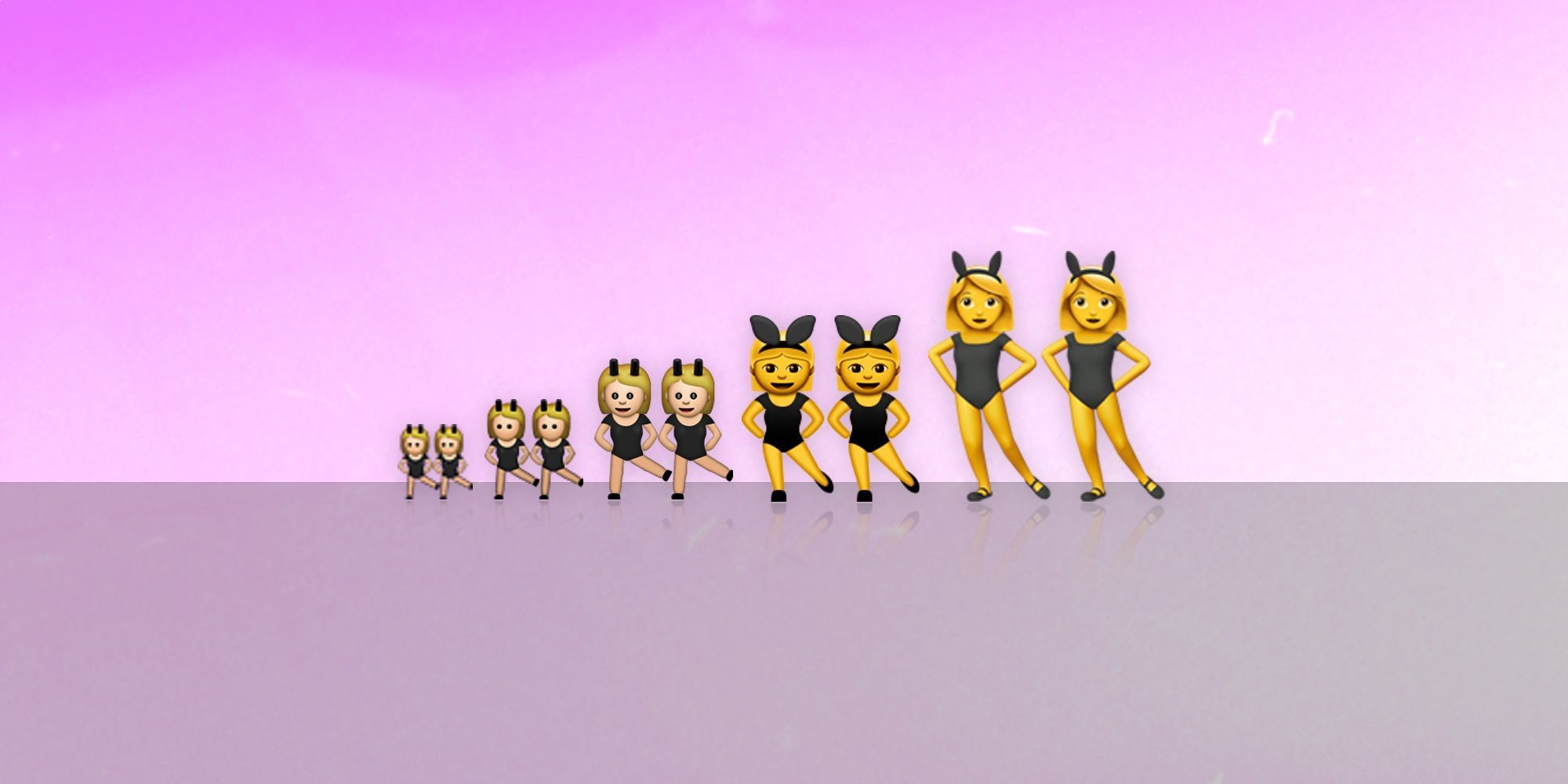
On November 21, 2008 Apple released a free software update for iPhone users in Japan which contained Apple's first emoji font and keyboard.
Ten years later, it's clear that this release paved the way for the widespread emoji support we see around the world today.
Background
When entering the Japanese market in 2008, one key area of focus for Apple was including emoji support on the newly released iPhone 3G.
This emoji support came in the form of a software update known as iPhone OS 2.2 (iPhone OS is what is now known as iOS) that was released globally, although the emoji keyboard was restricted to the Japanese market only.[1]
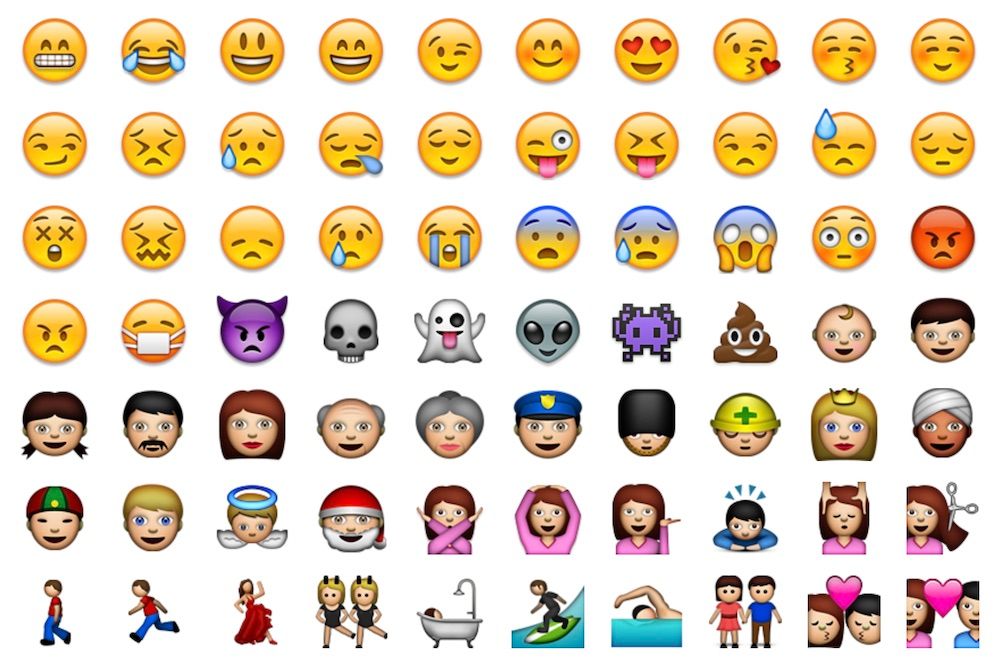
Above: Emoji designs on iPhone OS 2.2 in 2008.
Apps soon began including Easter Eggs which unlocked the emoji keyboard for users outside of Japan. This was not supported or endorsed by Apple but nonetheless emoji use outside of Japan initially spread via these workarounds.
At the time emoji support was first implemented, this was done in a way that was compatible with SoftBank (Apple's iPhone release partner in Japan), but emoji support had yet to come to Unicode which would make the characters universally interchangable between devices, carriers and software platforms for the first time.
Timeline
- 🎌 2008: iPhone OS 2.2 is released on November 21 with an emoji keyboard and emoji font for the first time. Restricted to Japan, but could be unlocked via third party apps.
- ⏫ 2010: iOS 4.0 is released and includes minor updates to the emoji font that goes on to be included in Mac OS X Lion a year later (July 20, 2011) - the first time the Mac had emoji support.
- 📲 2011: In iOS 5.0 the emoji keyboard could be activated by anyone around the world with a quick trip to the settings app - no workarounds needed.
- 🌐 2012: With the release of iOS 6.0 in September 2012, 376 new emojis were shown on the emoji keyboard for the first time.[1:1] 2012 was also the year Apple switched to using Unicode-compatible code points for emoji.[2]
- 🎉 2015: iOS 8.3 is released with new emojis for the first time in three years. Additions included switching the default skin tone from white to yellow, skin tone options added and families with single sex parents.
In 2015 the emoji keyboard was enabled for all iOS users by default. And in doing so created the momentum for the emoji keyboard became the world's most popular keyboard.
Global Reach
Emoji was added to the Unicode Standard in October 2010, which was a key step in ensuring that emoji characters could be cross-platform compatible around the world. Prior to this, carriers in Japan each had competing emoji implementations which were only partially compatible with one another.
Apple's 2008 emoji implementation was based on the set used by Japanese carrier Softbank, and the influence on many of these designs is clear.
Even moreso—much the the chagrin of some—Apple's emoji font has gone on to dominate public expectation of what an emoji should look like.
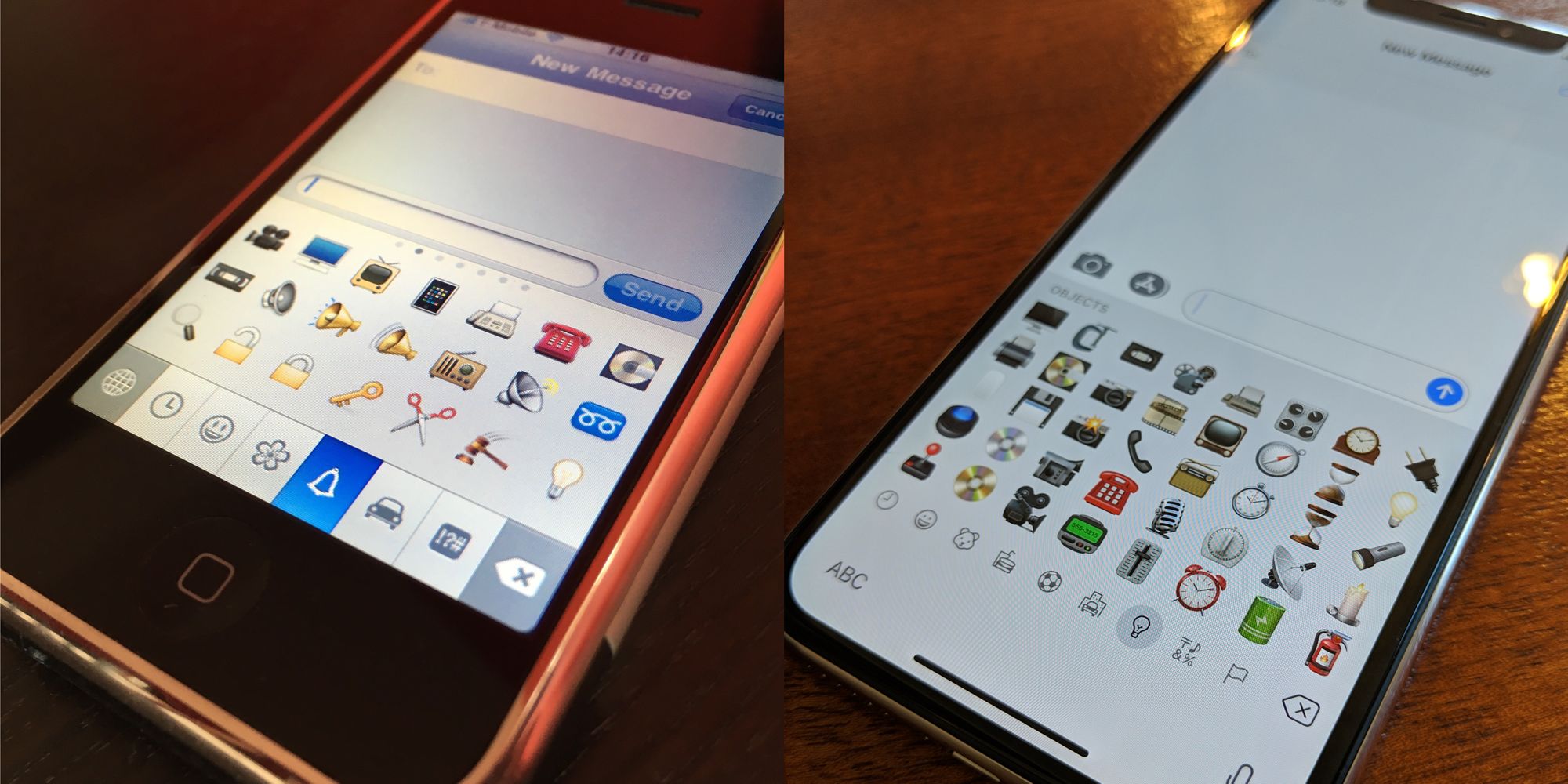
Above: Apple's emoji keyboard in 2008 (left) and 2018 (right). Photos: Jeremy Burge.[3]
While Apple does not dictate which emojis are approved by Unicode,[4] it is reasonable to wonder that without Apple's strong color emoji support in these earlier years, whether we would see it as the cultural phenomenon it has become today.[5]
A Continual Work In Progress
Over the years, many changes have been made to Apple's emoji set. The total number of emojis has increased from 471 in 2008 to 2,776 in 2018 - many as a result of gender and skin tone support.
Some changes have been purely aesthetic (Apple switched to 3D rendered designs in 2016) while others reflected the formal names of emojis when they were added to the Unicode Standard.[6]
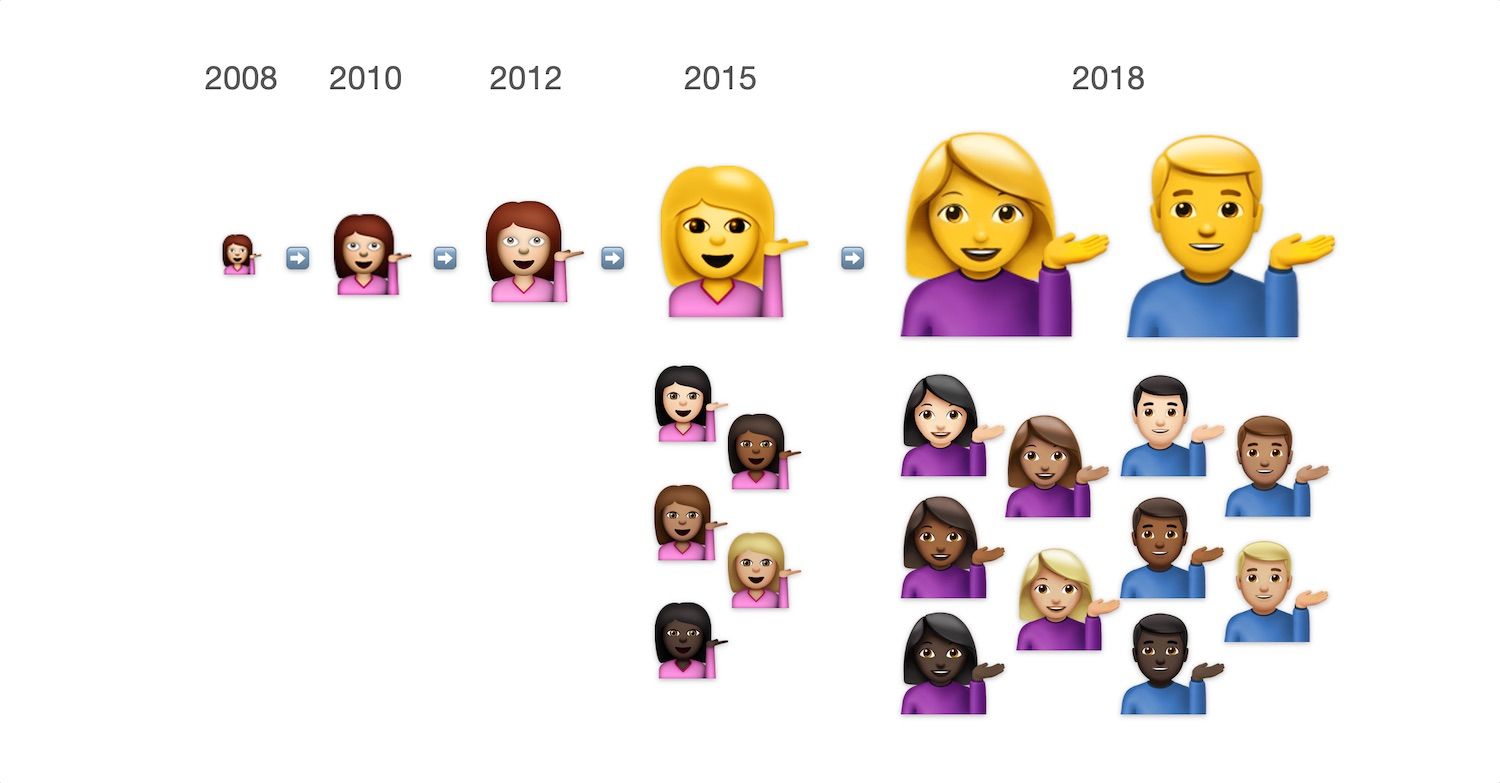
Above: Emoji evolution on iOS 2008–2018. Image: Apple / Emojipedia composite.
Vice President of User Interface Design Alan Dye oversees Apple's emoji designs and I asked him about these design updates earlier in the year.
Regarding the major emoji redesign of 2016, Dye explained than in part Apple's latest redesigns were due to the addition of high resolution retina displays across the Apple lineup:
“We’ve increased the resolution of our displays quite dramatically over the years and we had to do something if we wanted to improve on it. In a very practical sense, if we wanted to display our emojis at a larger scale, we really had to rerender them.”
Given that Apple's first emoji font contained 32x32 pixel bitmapped images, even if the source files were larger and more detailed, there's no doubt a point would have came where recreating them would have been considered the best choice.
Asked about whether Apple's Animoji and Memoji features were factors in updating the emoji set to highly detailed 3D designs, Dye hinted that his team “had a sense it was coming” though clarified that “at the same time we wanted to add an additional capability even just as a static emoji to allow for more expressive variation.”
Changes
😲 Astonished Face previously displayed Xs for eyes.

👼 Baby Angel was previously white and had a blue halo.

🏦 Bank previously displayed the letters BK.[7]

🛀 Person Taking Bath previously showed a person without any facial features. This emoji now supports skin tones.
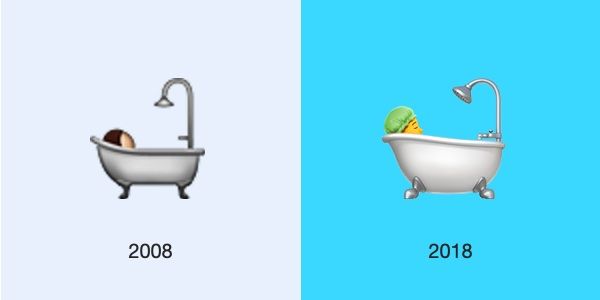
🚏 Bus Stop previously showed style of bus stop found in Japan, and now shows a bus stop sign similar to those found in Cupertino.
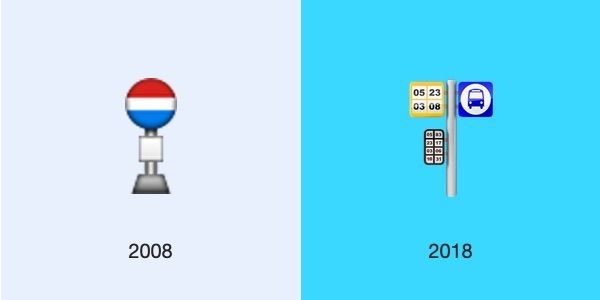
💃 Woman Dancing gained eyes, a mouth, nose, and hands.
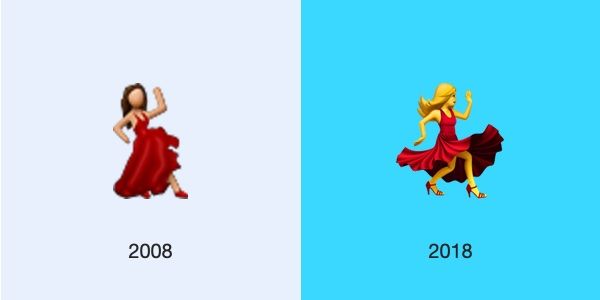
⛪ Church no longer uses a default Photoshop texture for the stained glass.
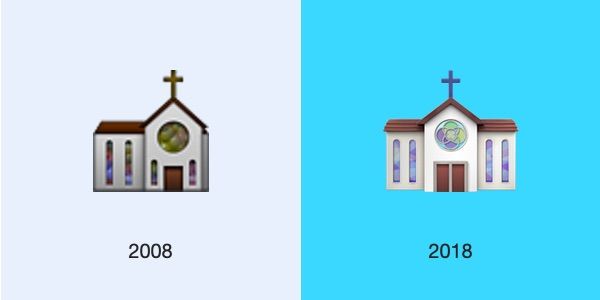
🍳 Cooking was previously shown as a cracked egg, later changed to an egg in a frying pan.

🍆 Eggplant (aka Aubergine) has retained its familiar shape over the years, but did lose the shadow.
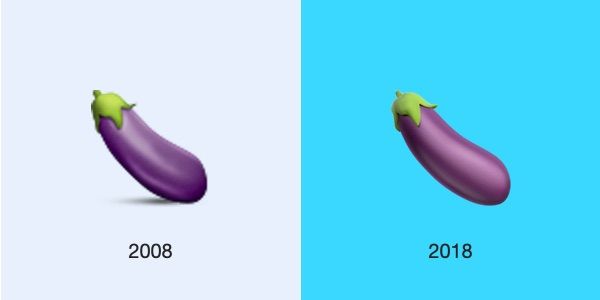
👷 Construction Worker no longer displays the green plus / cross on the helmet (used in Japan as a safety reminder in construction zones).
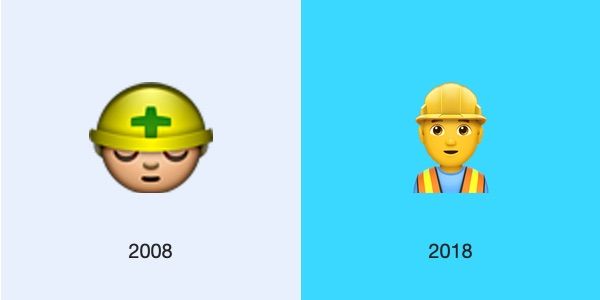
🐫 Two-Hump Camel (aka Bactrian Camel) has a more detailed appearance in 2018.
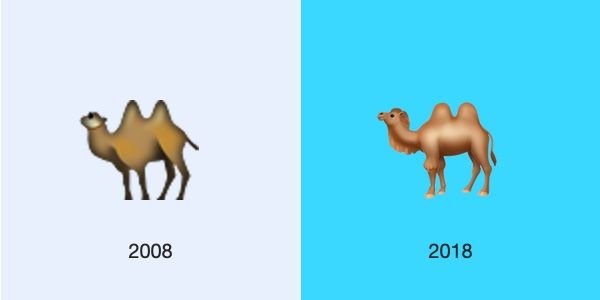
🏰 Castle removed the "picture frame" look that accompanied many early iOS emojis.
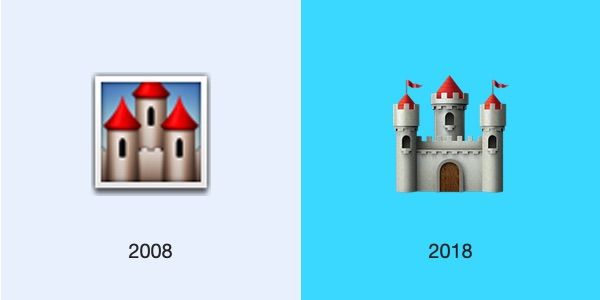
💻 Laptop Computer, known by its Unicode character name "Personal Computer" initially, has seen frequent updates to match new Apple hardware. A current iMac is now available via the separate 🖥️ Desktop Computer emoji.
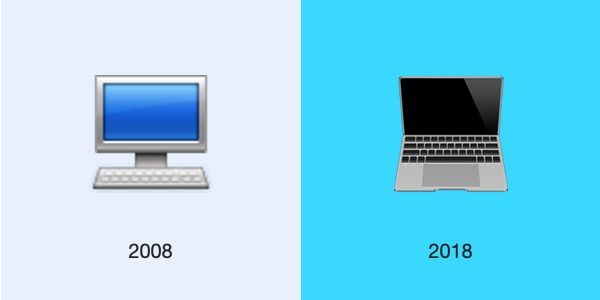
🏪 Convenience Store still shows a prominent 24 but with a newly 3D rendered design.
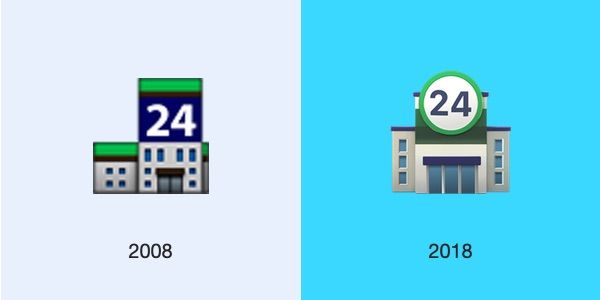
🍂 Fallen Leaf added a third leaf in 2016.
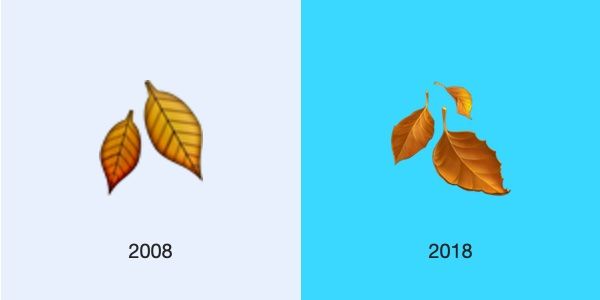
📠 Fax Machine has been updated to a newer model with a larger screen.
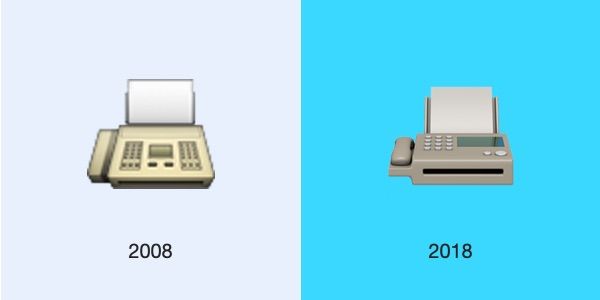
🙏 Folded Hands once had a glow behind the hands, but now it does not.
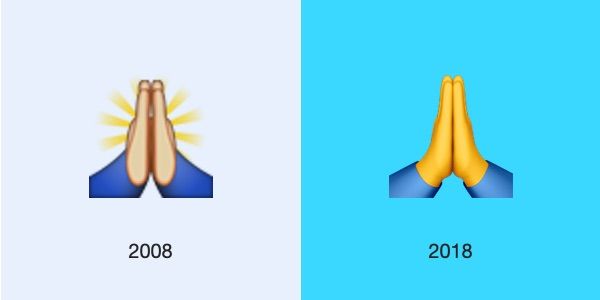
⛲ Fountain retains three tiers, but no longer shows the background scene behind the emoji.

⛳ Flag in Hole is used for the representation of golf. Previously showing a golf ball, this now matches the Unicode name for the character.

🎓 Graduation Cap started out as a black shirt with gold buttons.

😁 Beaming Face With Smiling Eyes (original name: Grinning Face With Smiling Eyes) was previously inconsistent with other platforms which always displayed this a happy grin. Changed to be more cross-platform compatible in 2016, many miss the previous version which was like the 😬 Grimacing Face with smiling eyes. Perhaps it could come back in future as a new emoji.

👲 Man With Chinese Cap (original name: Man With Gua Pi Mao) existed in original Japanese emoji sets as a character to represent a "sterotypical Chinese person". Over time this design was updated to make the Gua Pi Mao (traditional Chinese cap) the distinguishing feature of this emoji.

🔨 Hammer started as a mallet or gavel on early platforms. This standardized with the name "hammer" in the Unicode Standard, and designs were updated to match.
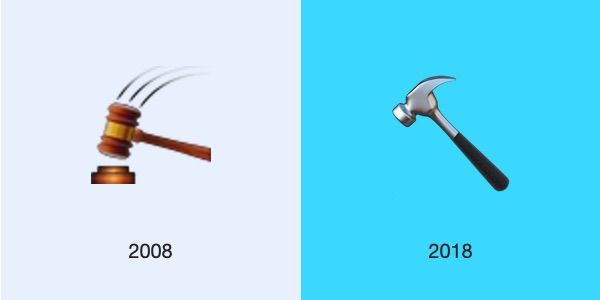
👫 Man and Woman Holding Hands were previously shown as white, and due to the small size of the emoji, did not show a mouth or nose.
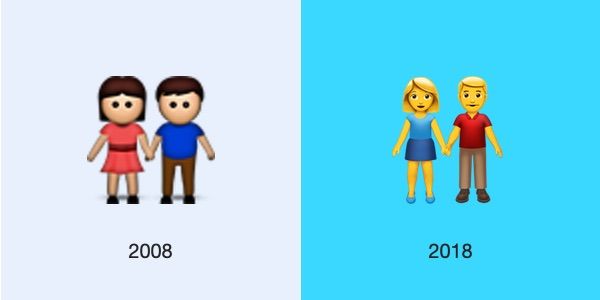
💁 Person Tipping Hand (original name: Information Desk Person) may be one of the more iconic designs from the original Apple emoji set. Often used for "sassiness", her spirit lives on in the version available today.
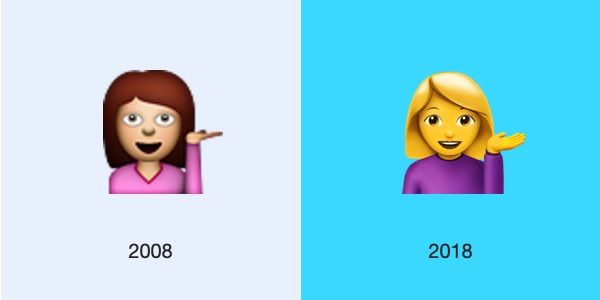
🗽 Statue of Liberty arguably missed the most prominent feature in 2008 (the torch) which is clear in 2018.
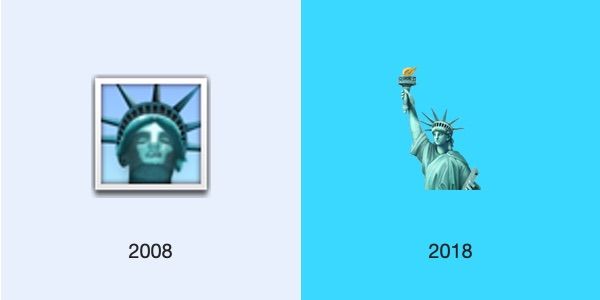
🚇 Metro was previously grouped with symbols, later given a realistic appearance and placed alongside other transport options. This now shows the characters IL2 which could be a reference to one of the more locked-down buildings at Apple's Infinite Loop Headquarters (IL2 = Infinite Loop 2).
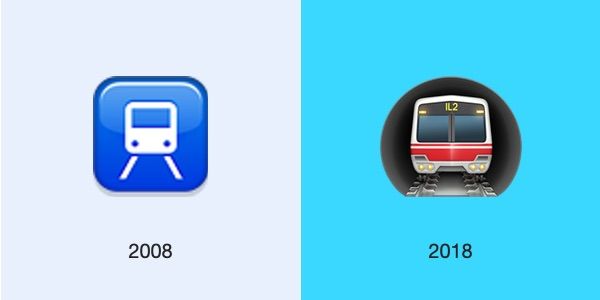
📱 Mobile Phone now appears as an iPhone X-series model. For a few years, a white-faced iPhone 5-series was shown.
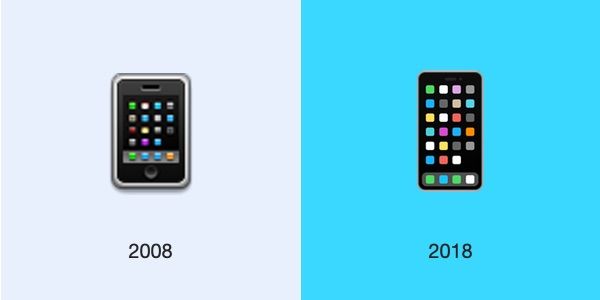
🔫 Pistol saw a controversial change from Apple in 2016, when they were the only vendor switching from a realistic firearm to a toy water pistol design. All other vendors made a similar change in 2018.
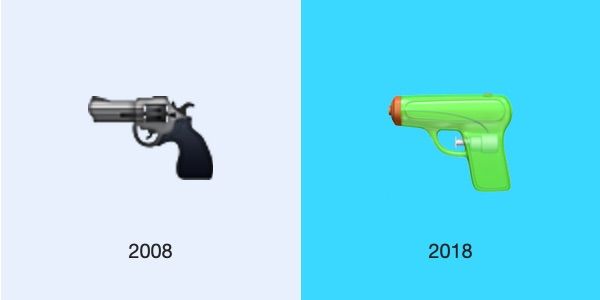
🚀 Rocket is reminiscent of the original design despite a considerable redesign.
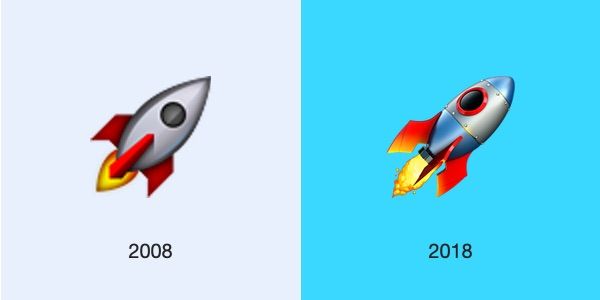
🏃 Person Running (original name: Runner) was like many early designs that often chose a (white) man to represent active roles such as sports or professions. Future Unicode updates provided mechanisms to support skin tone and gender variations. The base character remains showing a man for backward-compatibility, though the skin tone switched to yellow by default.
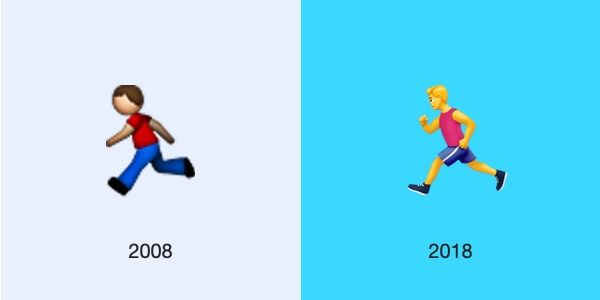
🎒 Backpack (original name: School Satchel) originally showed a style of bag used in Japanese schools.
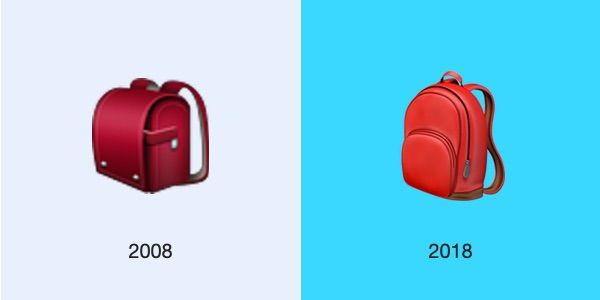
🐚 Spiral Shell was updated to its current design after Unicode standardized on the current name.
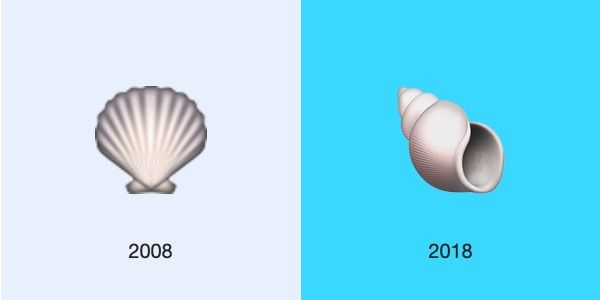
♠️ Spade Suit once showed a card around the suit character (as per the SoftBank design) which was later removed.
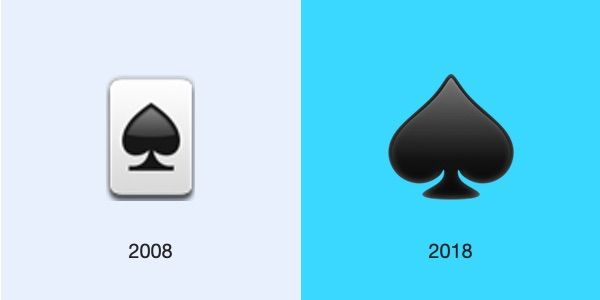
🌄 Sunrise Over Mountains has changed appearance over the years but retains the essence of the original design.
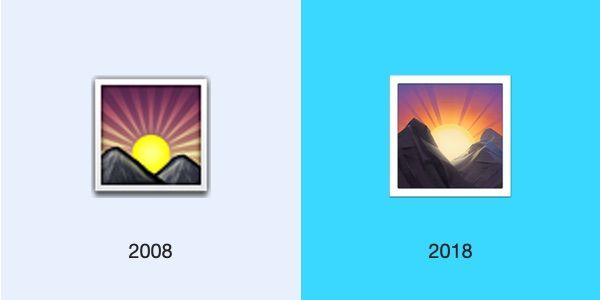
😂 Face With Tears of Joy, like most of the original smileys in Apple's emoji set, has stayed almost identical over the years.
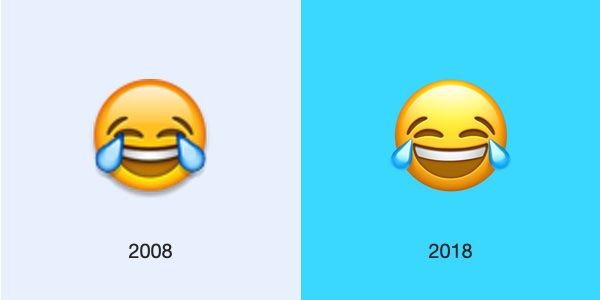
📳 Vibration Mode previously showed as a phone with a heart, but now shows lines for vibration.[8]
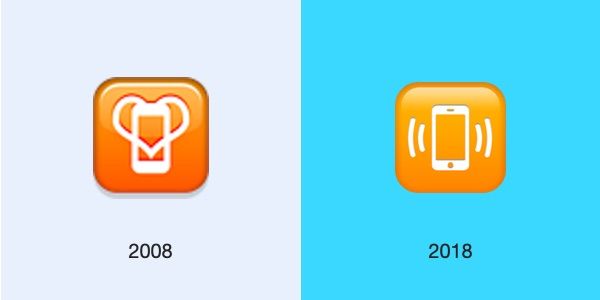
🎫 Ticket has changed from blue to yellow, and at one stage listed the tour as being for Johnny Appleseed.

🎐 Wind Chime appears with more detail in today's version than has been shown before.
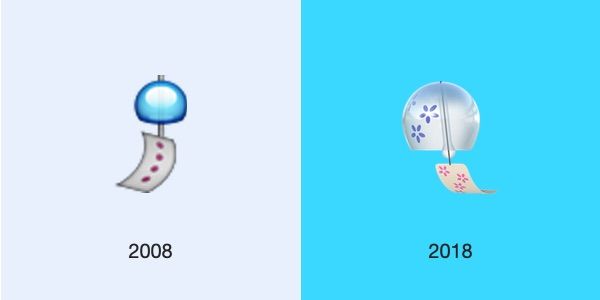
Shibuya no longer works on any current iPhone. This emoji existed in Japan prior to Unicode standardized of the emoji set, and was excluded from the Unicode Standard due to being a representation of a specific department store brand.
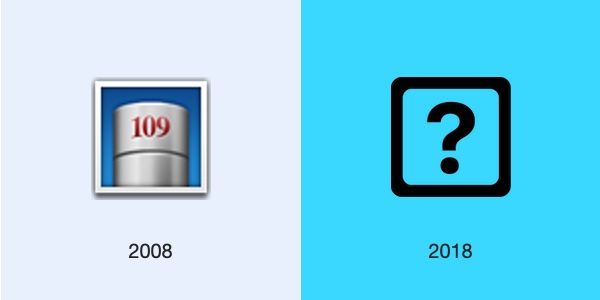
Apple and Emoji Today
From humble beginnings, emoji support on iOS has gone from a compatibility feature for one country in 2008 to a key part of Apple's messaging and iOS brand in 2018.
Tim Cook tweets about World Emoji Day, WWDC 2018 included a lengthy segment about the highly customizable Memoji feature, and Apple uses emoji for promotion in TV ads, on T Shirts, and as part of Apple Store decor.
Earlier this year Apple proposed new accessibility emojis to represent people with canes, wheelchairs, hearing aides and more.
Not only do emoji updates appear to provide users with better ways to communicate, they also inadvertantly drive iOS updates. The social effect of receiving a missing character box instead of a new emoji is a strong incentive for users to update to new iOS versions.
Regarding the future scalability of emoji when it comes to areas such as diverse families, Dye told Emojipedia “I’ll just say it’s something we’re working on, we just need a UI that can accommodate that”.
Provided the emoji keyboard continues to adapt to future diversity challenges, it seems clear that emoji on iOS is a win-win for both Apple and Apple users.
Resources
Emojipedia includes emoji archives dating back over a decade. Click or tap any emoji image to view historical entries.
📜 Delve into our emoji archive you never know the treasures you might find 👼 https://t.co/pmo9t32y8O pic.twitter.com/agy5058d5d
— Emojipedia 🦃 (@Emojipedia) April 6, 2018
Related: find out who designed the original Apple Emoji set.
Browse each version of Apple's emoji collection over the years:
- Apple iOS 12.1
- Apple iOS 11.3
- Apple iOS 11.2
- Apple iOS 11.1
- Apple iOS 10.3
- Apple iOS 10.2
- Apple iOS 10.0
- Apple iOS 9.3
- Apple iOS 9.1
- Apple iOS 9.0
- Apple iOS 8.3
- Apple iOS 6.0
- Apple iOS 5.1
- Apple iOS 5.0
- Apple iOS 4.0
- Apple iPhone OS 2.2
A minor update in March 2012 (iOS 5.1) was actually the first to show 363 of these new emojis, but non were not yet shown on the emoji keyboard at the time. Quirks with this release included the new 📙 Orange Book emoji appearing in purple. ↩︎ ↩︎
This was also when Apple began clamping down on apps that purely provided an ability to unlock the built-in emoji keyboard. Despite this, there was a widespread misconception for years after that new emoji updates were provided by third party emoji keyboard apps, not the system. ↩︎
Worth noting here that Gmail, too, added emoji supported in 2008. Apple and Google were both key movers in getting emoji added to the Unicode Standard. Here's a great read on this timeframe. ↩︎
Note: Apple is a voting member of the Unicode Consortium, as is Emojipedia. ↩︎
For instance ⛳ Flag in Hole that previously displayed as a golf ball, prior to each emoji having a name. When the name "flag in hole" was set for the golf character, the design changed to reflect this. ↩︎
This emoji came to be used for "slacking off" or evading responsibility in Japan, due to the BK letters being associated with the slang term bakkureru. ↩︎
Similarly, 👱 Person With Blond Hair existed in Japan to represent a European / Caucasian person and was shown with an exaggerated long nose on some platforms. ↩︎
I'm not sure of the origin of the heart. I could make a guess, but if someone knows do get in touch. Update: Alex Reid with an explanation and pictures to go with it: 'you definitely see similar iconography on some signs in Japan telling you to switch your phone to silent (or ‘manner mode’), and in some phone UI, especially Sharp phones' ↩︎
